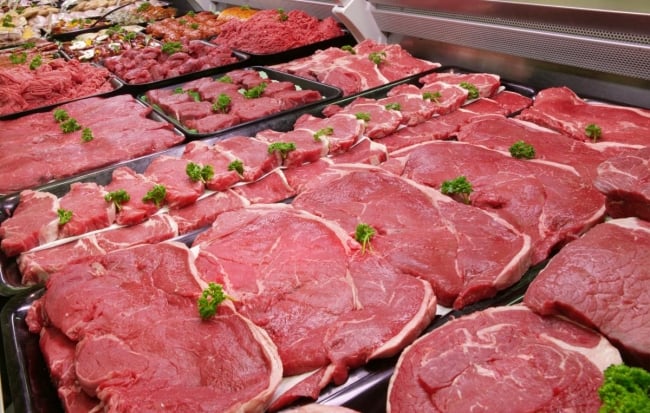You have /5 articles left.
Sign up for a free account or log in.

Red meat is out and plant-based options are in at some colleges fighting climate change in the dining hall.
iStock / Getty Images Plus
Beans instead of beef, falafel in place of pork, burgers bursting with grains. These are just a few of the changes found in some college dining halls, where cafeteria workers are serving up food with a side of sustainability from menus that consider climate change alongside student nutritional needs.
As the climate crisis worsens, with rising temperatures and water levels, colleges are trying to build out sustainability initiatives to lessen their carbon footprints. And at some colleges, that effort is playing out on students’ dinner plates.
Given the effects on the planet of meat production—which is not as damaging as burning fossil fuels, but still a significant contributor to carbon emissions—some colleges are pushing more plant-based options and scaling back on red meat.
These efforts are coupled with broader sustainability initiatives that consider the role food production and consumption play in generating greenhouse gases and filling landfills.
“The main way that livestock contributes to climate change is through emissions of methane,” explained Aaron Smith, an agricultural economist at the University of California, Davis. “So when cattle eat grasses and other sort of fibrous foods that humans wouldn’t really be able to digest, there are microbes in their stomach that process those, and as they do that, those microbes emit methane and methane comes out from the cow in the form of burps and manure.”
Considering the climate impact generated by cattle and other sources of red meat, some institutions have set specific targets to reduce meat consumption, scaling back year by year.
Targeted Reductions of Red Meat
Brown University, for one, has goals of reducing red meat consumption by 25 percent by 2025 and then 50 percent—or greater—by 2030, as outlined in its sustainability plan.
Jessica Berry, director of sustainability at Brown, said the university is on track to meet its goals, though the data have been skewed amid a pandemic that saw the dining halls empty out.
“Ultimately, under the sustainability plan, part of the longer-term thinking is to get to a 50 percent reduction by 2030,” Berry said. “We will continue to work with Brown Dining Services and the chefs there to come up with creative ways to do that. One of the key components of this is the importance of educating students on the climate impact of their food choices, and for them to be able to make informed decisions about their carbon footprint when it comes to food choices.”
Berry is quick to point out that “reduction doesn’t mean elimination.” Students, faculty and staff can still find a beef burger in Brown’s dining facilities, though those offerings may appear less frequently. Additionally, they may see alternatives such as turkey burgers or other proteins. And the composition of beef burgers may also be altered, adding in grains to use less meat over all.
Smith College aims to reduce consumption of red meat by 15 percent by 2024, dialing it back by 5 percent each year. To meet that target, the college plans to incorporate more plant-based options, said Andy Cox, executive director of auxiliary services at Smith.
“Creating more plant-based options is where we’re focusing now,” Cox explained, adding that “there’s a fair amount of flexitarians on campus where a meal, to them, doesn’t require meat.”
Beyond meeting climate goals, Cox said, the university is responding to student wants.
“I feel like we’re getting more requests for plant-based options than for meat,” Cox said.
Like Berry, he emphasizes that less meat doesn’t mean no meat. But customers in Smith dining halls may see meat showing up less frequently, replaced by burgers made with black beans or other proteins in place of beef. And though meat alternatives have proven popular with the public, that isn’t so at Smith.
“We have tried to be on trend with a lot of plant-based meats, and we find that a fake meat burger, like Beyond or Impossible, is actually less popular than a black bean burger,” Cox said.
However, compared to some U.K. colleges, even the more aggressive goals at U.S. universities seem almost mild, focusing on a staggered approach to reduce red meat consumption over time. By contrast, catering services at the University of Cambridge in the U.K. dropped beef and lamb from their menus, among other moves, in 2016 in an effort to combat climate change. Three years later, they reported the carbon footprint of University Catering Services had dropped by 10.5 percent.
Another U.K. institution—Goldsmiths, University of London—made a similar move in 2019, banning the sale of beef in food outlets on campus in an effort to become carbon neutral by 2025.
While some students at Brown are critical of the vegan options, racking up views on TikTok by making fun of the choices they see as unappetizing, others feel the university isn’t going far enough.
Benny Smith, a junior at Brown, worries that swapping out beef or pork for another meat comes with drawbacks, and he would prefer to see the university substitute plant-based options for red meat instead of replacements such as fish or poultry from factory farms.
“This kind of replacement has climate benefits, but is detrimental in other ways—in particular, it is harmful from an animal welfare perspective, because chickens, turkeys and fish are much smaller animals than pigs or cows,” Benny Smith wrote in an email. “In other words, let’s say Brown has a choice between ordering 100 pounds of chicken or 100 pounds of pork: since chickens are much smaller animals, far more animals are abused on factory farms to produce the 100 pounds of chicken.”
Despite this objection, Benny Smith says, “Brown has been great about making plant-based options available in the dining halls.”
Cutting back on meat isn’t the only way colleges look to reduce the carbon footprints of campus dining services. Whenever possible, both Brown and Smith buy local, to reduce food waste and compost. Reducing food waste is vital, especially in Rhode Island, where Brown is located, which has only one landfill, which is rapidly filling up.
“It’s really important that Brown does its part in diverting as much waste as possible,” Berry said.
Other Sustainability Efforts
Across the nation, in beef country, sustainability efforts play out a little differently. Montana State University, a college with a strong agricultural program, isn’t focused on reducing red meat consumption but rather on where its ingredients come from and how they’re used.
“At this point in time, about a quarter of all of our food purchased is from the state of Montana,” said Kara Landolfi, supply chain manager at MSU. “We will continue to try and expand that as more ingredients are accessible to us, and as we’re able to integrate them into our menus.”
The emphasis isn’t just on local, but hyperlocal food production, which cuts down on the emissions generated in transporting food to campus. Much of the beef consumed in Montana State’s dining hall comes from about a mile away, where agriculture students raise steers for consumption, which are donated to the college by local farmers and ranchers.
A program that started with just a handful of steers now provides about 30 a year. Ag students also raise lambs for consumption, and the university purchases pigs at local auctions that have been raised by members of 4H, a national youth organization.
Montana State also has a vegetable garden near campus operated by students in the sustainable food systems major. Some of those vegetables go to campus dining halls. Landolfi also points to locally sourced fryer oil, honey, kombucha and various other products.
In all, more than 100 Montana vendors contribute to the campus dining experience.
“When a local product comes to market, if it has a place within our operations, and we can access it readily, and we can work it into our operations economically, then we’ll put it in as best we can,” Landolfi said. “There will never be a day that we can be 100 percent local, because we do offer foods for all people to meet people’s dietary preferences and needs, and there are some things that you just are never going to be able to get within Montana or even the West.”
Beyond localizing production to cut down on vehicle emissions, Landolfi points to food waste reductions and composting as part of the larger sustainability plan.
Changing Consumer Behaviors
According to a 2020 Gallup poll, about one in four Americans, or 23 percent, reported eating less meat than in the prior year, citing both health and environmental reasons for the cutback.
But globally, meat consumption—and the greenhouse gases that accompany it—are on the rise. Aaron Smith, at UC Davis, notes that rising incomes in poorer countries allow for an expansion of diets.
“As countries and as people get richer, they are able to diversify their diets and eat more tasty things,” Aaron Smith said. “In poorer societies, people tend to eat much more basic foods, so a lot of rice and grains. As we get richer, we feed the grains to an animal and eat the animal instead.”
He’s skeptical that changing the offerings in campus dining halls will have much of an effect on climate change, since burning fossil fuels produces more greenhouse gas emissions than agriculture. In a post on his website, he tried to determine how guilty he should feel for eating beef and found that eating an 8-ounce steak was roughly equivalent to driving 21 miles in terms of environmental impact.
“I think [these efforts] can be symbolic, and maybe it helps move some people’s preferences away from red meat and towards other things, but predominantly people eat what they like,” Aaron Smith said, noting that if burgers aren’t available on campus, students will find them elsewhere.
The most significant impact of reducing red meat in campus dining halls won’t happen during a student’s college years but rather through the choices they make as a consumer over the course of a lifetime, he said. Colleges have to change more than menus; they have to change students’ minds. In the dining hall, like in the classroom, it’s all about education.
“If it sets people up for a change in lifetime habits, then that could reduce emissions,” Aaron Smith said.




